| Maintenance Service Interval | Maintenance Procedure |
|---|---|
| Before each use or daily |
|
Introduction
Warning
CALIFORNIA
Proposition 65 Warning
The engine exhaust from this product contains chemicals known to the State of California to cause cancer, birth defects, or other reproductive harm.
Important: This engine is not equipped with a spark arrester muffler. It is a violation of California Public Resource Code Section 4442 to use or operate the engine on any forest-covered, brush-covered, or grass-covered land. Other states or federal areas may have similar laws.
This spark ignition system complies with Canadian ICES-002.
The enclosed Engine Owner's Manual is supplied for information regarding the US Environmental Protection Agency (EPA) and the California Emission Control Regulation of emission systems, maintenance, and warranty. Replacements may be ordered through the engine manufacturer.
Read this information carefully to learn how to operate and maintain your product properly and to avoid injury and product damage. You are responsible for operating the product properly and safely. Keep for future reference.
You may contact Toro directly at www.Toro.com for product and accessory information, help finding a dealer, or to register your product.
Whenever you need service, genuine Toro parts, or additional information, contact an Authorized Service Dealer or Toro Customer Service and have the model and serial numbers of your product ready. Figure 1 identifies the location of the model and serial numbers on the product.
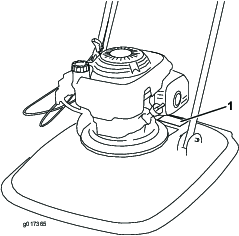
Write the product model and serial numbers in the space below:
This manual identifies potential hazards and has safety messages identified by the safety alert symbol (Figure 2), which signals a hazard that may cause serious injury or death if you do not follow the recommended precautions.

This manual uses 2 words to highlight information. Important calls attention to special mechanical information and Note emphasizes general information worthy of special attention.
For models with stated engine horsepower, the gross horsepower of the engine was laboratory rated by the engine manufacturer in accordance with SAE J1349. As configured to meet safety, emission, and operating requirements, the actual engine horsepower on this class machine will be significantly lower.
Safety
This cutting machine can amputate hands and feet and throw objects. Failure to observe the following safety instructions could result in serious injury or death.
The following safety section is adapted from ANSI B71.4–2012.
General Operation
-
Read the Operator’s Manual and other training material. If the operator(s) or mechanic(s) cannot read English it is the owners responsibility to explain this material to them.
-
Become familiar with the safe operation of the equipment, operator controls, and the safety signs.
-
All operators and mechanics should be trained. The owner is responsible for training the users.
-
Never let children or untrained people operate or service the equipment. Local regulations may restrict the age of the operator.
-
The owner/user can prevent and is responsible for accidents or injuries occurring to themselves, other people, or property.
-
Do not put hands or feet near or under the machine.
-
Evaluate the terrain to determine what accessories and attachments are needed to properly and safely perform the job. Only use accessories and attachments approved by the manufacturer.
-
Clear the area of objects such as rocks, wire, toys, etc., which could be thrown by the blade. Stay behind the handle when the engine is running.
-
Be sure the area is clear of bystanders before operating. Stop machine if anyone enters the area.
-
Wear appropriate clothing including hard hat, safety glasses, and hearing protection. Long hair, loose clothing, or jewelry may get tangled in moving parts.
-
Do not pull machine backward unless absolutely necessary. Always look down and behind before and while moving backward.
-
Slow down and use caution when making turns and crossing roads and sidewalks.
-
Material may ricochet back toward the operator. Do not operate over gravel surfaces.
-
Check that the operator’s presence controls, safety switches, and shields are attached and functioning properly. Do not operate unless they are functioning properly.
-
Never leave a running machine unattended.
-
Stop the engine and wait until the blade comes to a complete stop, and remove the spark plug wire before cleaning or unclogging the machine.
-
Operate machine only in daylight or good artificial light.
-
Do not operate machine while under the influence of alcohol or drugs.
-
Never operate machine in wet grass. Always be sure of your footing; walk; never run.
-
Never raise the deck with the engine running.
-
If the machine should start to vibrate abnormally, stop the engine and check for the cause immediately. Vibration is generally a warning of trouble.
-
Use care when loading or unloading the machine into a trailer or truck.
Slope Operation
Slopes are a major factor related to slip and fall accidents, which can result in severe injury. Operation on all slopes require extra caution. If you feel uneasy on a slope, do not mow it.
-
Mow across the face of slopes; never up and down. Exercise extreme caution when changing direction on slopes.
-
Watch for holes, ruts, bumps, rocks, or other hidden objects. Uneven terrain could cause a slip and fall accident. Tall grass can hide obstacles.
-
Do not mow on wet grass or excessively steep slopes. Poor footing could cause a slip and fall accident.
-
Do not mow near drop-offs, ditches, or embankments. You could lose your footing or balance.
-
When using the machine, always keep both hands on the handlebar.
-
When cutting steep slopes from the top of the slope and a longer reach is needed, never tie the machine to a rope, use the extended handlebar kit option.
Children
Tragic accidents can occur if the operator is not alert to the presence of children. Children are often attracted to the machine and the mowing activity. Never assume that children will remain where you last saw them.
-
Keep children out of the mowing area and under the watchful care of a responsible adult other than the operator.
-
Be alert and turn machine off if a child enters the area.
-
Never allow children to operate the machine.
-
Use extra care when approaching blind corners, shrubs, trees, or other objects that may block your view of a child.
Service
Safe Handling of Gasoline
To avoid personal injury or property damage, use extreme care in handling gasoline. Gasoline is extremely flammable and the vapors are explosive.
-
Extinguish all cigarettes, cigars, pipes, and other sources of ignition.
-
Use only an approved gasoline container.
-
Never remove gas cap or add fuel with the engine running. Allow engine to cool before refueling.
-
Never refuel or drain the machine indoors.
-
Never store the machine or fuel container where there is an open flame, spark, or pilot light such as on a water heater or on other appliances.
-
Never fill containers inside a vehicle or on a truck or trailer bed with a plastic liner. Always place containers on the ground away from your vehicle before filling.
-
Remove gas-powered equipment from the truck or trailer and refuel it on the ground. If this is not possible, then refuel such equipment with a portable container, rather than from a gasoline dispenser nozzle.
-
Keep the nozzle in contact with the rim of the fuel tank or container opening at all times until fueling is complete. Do not use a nozzle lock-open device.
-
If fuel is spilled on clothing, change clothing immediately.
-
Never overfill fuel tank. Replace gas cap and tighten securely.
Warning
Exhaust contains carbon monoxide, an odorless, deadly poison that can kill you.
Do not run the engine indoors or in an enclosed area.
General Service
-
Never operate machine in a closed area.
-
Keep all nuts and bolts tight to be sure the equipment is in safe working condition.
-
Never tamper with safety devices. Check their proper operation regularly.
-
Keep machine free of grass, leaves, or other debris build-up. Clean up oil or fuel spillage and remove any fuel-soaked debris. Allow machine to cool before storing in an enclosed space.
-
Never make any adjustments or repairs with the engine running. Disconnect the spark plug wire and ground against engine to prevent unintended starting.
-
Do not change the engine governor setting or overspeed the engine.
-
Maintain or replace safety and instruction labels, as necessary.
-
If gasoline is spilled, do not attempt to start the engine but move the machine away from the area of spillage and avoid creating any source of ignition until the gasoline vapor has dissipated.
-
Replace faulty silencers.
-
Before using, always visually inspect to see that the blade, bolts and spacers are not worn or damaged. Replace a worn or damaged blade.
-
Stop the blade if the machine has to be tilted for transportation when crossing surfaces other than grass, and when transporting the machine to and from the area to be mowed.
-
Never pick up or carry a machine while the engine is running.
-
Stop the engine and disconnect the spark plug wire, make sure that all moving parts have come to a complete stop:
-
Before clearing blockages.
-
Before checking, cleaning, or working on the machine.
-
After striking a foreign object. Inspect the machine for damage and make repairs before restarting and operating the machine.
-
If the machine starts to vibrate abnormally.
-
Whenever you leave the machine.
-
Before refueling.
-
-
Ensure the engine and the fuel tank are empty of fuel before rotating the machine beyond a 45 degree angle.
-
Use care when checking the blades. Wrap the blade or wear gloves, and use caution when servicing them.
-
Keep hands and feet away from moving parts. If possible, do not make adjustments with the engine running.
-
Shut off the fuel while storing or transporting the machine. Do not fuel near open flames, and do not drain fuel indoors.
-
Park the machine on level ground. Never allow untrained personnel to service the machine.
-
Allow the engine to cool before storing in any enclosure.
-
Replace worn or damaged parts for safety.
-
If the fuel tank has to be drained, this should be done outdoors. The drained fuel should be stored in a container specifically designed for fuel storage or it should be disposed of carefully.
-
Start the engine carefully according to the Operator’s Manual and with feet away from the cutting elements.
-
Always wear ear protection.
-
When tilting the machine to start the engine, do not tilt it more than absolutely necessary and lift only the part which is away from the operator.
-
Examine the machine regularly and replace worn or damaged parts for safety. Use only Toro genuine spare parts.
Safety and Instructional Decals
Important: Safety and instruction decals are located near areas of potential danger. Replace damaged decals.

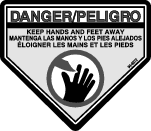
Setup
Assembling the Handle
-
Slide 2 bushes into the frame.
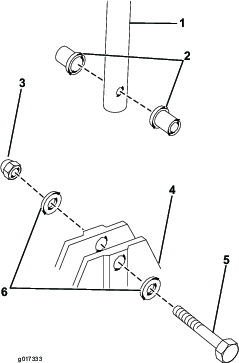
-
Place the lower handle between the bushes and secure it with 1 handlebar bolt, 2 washers, and 1 nut.
Note: Place the lower handle between the bushes with the kick stop assembly on the right hand side.
-
Repeat for the opposite side.
-
Align the holes on the upper handle with the lower handle.
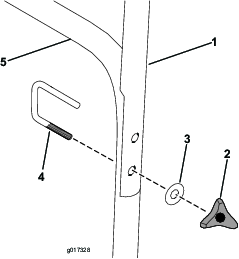
-
Fit the U bolt through the upper and lower handle and secure it with a washer and a hand wheel.
-
Attach the throttle assembly to the outside of the handlebar and secure it with a nut and a pan screw.
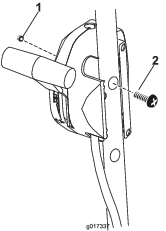
Filling the Engine with Oil
Important: Your machine does not come with oil in the engine. Before starting the engine, fill the engine with oil.
Max. fill: 0.59 l (20 oz.), type: SAE 30 or SAE 10W-30 detergent oil with an API service classification of SF, SG, SH, SJ, SL, or higher.
-
Move the machine to a level surface.
-
Remove the dipstick (Figure 6).
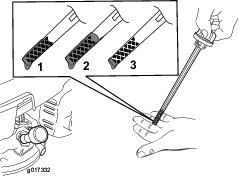
-
Slowly pour oil into the oil fill hole, wait 3 minutes, and check the oil level on the dipstick by wiping the dipstick clean and then inserting, but not screwing in, the oil fill cap into the hole (Figure 7).
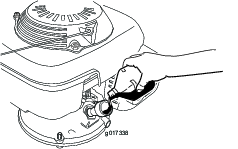
Note: Fill the engine crankcase with oil until the dipstick indicates that the engine oil level is correct as shown in Figure 6. If you overfill the engine with oil, remove the excess oil as directed in Changing the Engine Oil.
-
Install the dipstick and hand tighten it securely.
Important: Change the engine oil after the first 5 operating hours; change it yearly thereafter. Refer to Changing the Engine Oil.
Product Overview

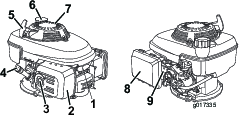
Operation
Filling the Fuel Tank
Danger
Gasoline is extremely flammable and explosive. A fire or explosion from gasoline can burn you and others.
-
To prevent a static charge from igniting the gasoline, place the container and/or machine directly on the ground before filling, not in a vehicle or on an object.
-
Fill the tank outdoors when the engine is cold. Wipe up spills.
-
Do not handle gasoline when smoking or around an open flame or sparks.
-
Store gasoline in an approved fuel container, out of the reach of children.
Recommended Fuel:
-
For best results, use only clean, fresh (less than 30 days old), unleaded gasoline with an octane rating of 87 or higher ((R+M)/2 rating method).
-
Ethanol: Gasoline with up to 10% ethanol (gasohol) or 15% MTBE (methyl tertiary butyl ether) by volume is acceptable. Ethanol and MTBE are not the same. Gasoline with 15% ethanol (E15) by volume is not approved for use. Never use gasoline that contains more than 10% ethanol by volume, such as E15 (contains 15% ethanol), E20 (contains 20% ethanol), or E85 (contains 85% ethanol). Using unapproved gasoline may cause performance problems and/or engine damage which may not be covered under warranty.
-
Do not use gasoline containing methanol.
-
Do not store fuel either in the fuel tank or fuel containers over the winter unless a fuel stabilizer is used.
-
Do not add oil to gasoline.
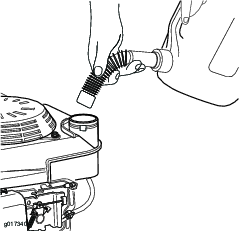
Checking the Engine Oil Level
-
Move the machine to a level surface.
-
Remove the dipstick and wipe it with a clean cloth.
-
Insert, but do not screw in, the dipstick into the oil fill hole.
-
Remove the dipstick and check it.
-
To determine the proper oil level on the dipstick, refer to Figure 11).

-
If the oil level is low, slowly pour oil into the oil fill hole, wait 3 minutes, and check the oil level on the dipstick by wiping the dipstick clean and then inserting, but not screwing in, the oil fill cap into the hole.
Note: Max. fill: 0.59 l (20 oz.) SAE 10W-30 detergent oil with an API service classification of SF, SG, SH, SJ, SL, or higher.
Note: Fill the engine crankcase with oil until the dipstick indicates that the engine oil level is correct as shown in Figure 11. If you overfill the engine with oil, remove the excess oil as directed in Changing the Engine Oil.
-
Install the dipstick and hand tighten it securely.
Important: Change the engine oil after the first 5 operating hours; change it yearly thereafter. Refer to Changing the Engine Oil.
Adjusting the Cutting Height
Warning
Adjusting the cutting height may bring you into contact with the blade, causing serious injury.
-
Stop the engine and wait for all moving parts to stop.
-
Wear gloves while handling the blade.
Caution
If the engine has been running, the muffler will be hot and can severely burn you. Keep away from the hot muffler.
Adjust the cutting height as desired.
-
Turn the fuel switch to the off position.
-
Disconnect the wire from the spark plug.
-
Tilt the machine on its left side.
-
Wearing protective gloves, remove the blade bolt and spacers.
-
Reposition the spacers to the desired height, reinstall the blade retainer and spacers (Figure 12,), and tighten the bolt to 25 N-m (18 ft-lbs).

Note: The large spacer must be positioned directly below the impeller at all times.
Starting the Engine
-
Place the throttle control to the choke position, ensure that the fuel switch is in the ‘On’ position.
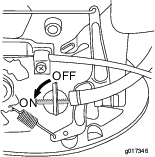
-
Hold the engine stop handle against the handle.
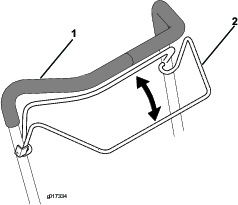
-
Place your foot on the deck and tilt the machine towards you (Figure 15).
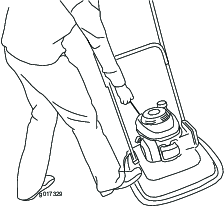
-
Pull the recoil start handle.
Note: If the machine does not start after several attempts, contact an Authorized Service Dealer.
Adjusting the Choke
Use the throttle assembly to adjust the choke (Figure 16).
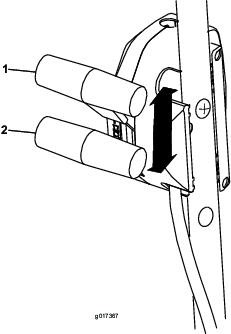
Stopping the Engine
| Maintenance Service Interval | Maintenance Procedure |
|---|---|
| Before each use or daily |
|
To stop the engine, release the blade control bar (Figure 17).
Important: When you release the engine stop handle, both the engine and blade should stop within 3 seconds. If they do not stop properly, stop using your machine immediately and contact an Authorized Service Dealer.
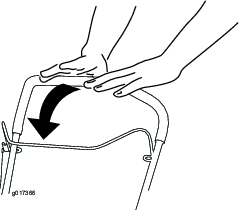
Operating Tips
General Mowing Tips
Warning
Operating the engine on a slope greater than 45° will severely damage the engine because of a lack of lubrication. Potential damage includes stuck valves, scored pistons, or burned crank bearings.
-
Before operating the machine on a slope, complete a site survey to measure the slope where you will operate the machine.
-
Do not operate the 4-cycle Honda engine on this machine on slopes greater than 45°.
-
Clear the area of sticks, stones, wire, branches, and other debris that the blade could hit.
-
Avoid striking solid objects with the blade. Never deliberately mow over any object.
-
If the machine strikes an object or starts to vibrate, immediately stop the engine, disconnect the wire from the spark plug, and examine the machine for damage.
-
For best performance, install a new blade before the cutting season begins.
-
Replace the blade when necessary with a Toro replacement blade.
Cutting Grass
-
Cut only about a third of the grass blade at a time. Do not cut below the 32 mm (1.25 inch) setting unless the grass is sparse or it is late fall when grass growth begins to slow down. Refer to Adjusting the Cutting Height.
-
Mowing grass over 15 cm (6 inches) in length is not recommended. If the grass is too long, the machine may plug and cause the engine to stall.
-
Mow only dry grass or leaves. Wet grass and leaves tend to clump on the yard and can cause the machine to plug or the engine to stall.
Warning
Wet grass or leaves can cause serious injury if you slip and contact the blade. Mow only in dry conditions.
-
Alternate the mowing direction. This helps disperse the clippings over the lawn for even fertilization.
-
If the finished lawn appearance is unsatisfactory, try one or more of the following:
-
Replace the blade or have the blade sharpened.
-
Walk at a slower pace while mowing.
-
Raise the cutting height on your machine.
-
Cut the grass more frequently.
-
Overlap cutting swaths instead of cutting a full swath with each pass.
-
Cutting Leaves
-
After cutting the lawn, ensure that half of the lawn shows through the cut leaf cover. You may need to make more than one pass over the leaves.
-
Slow down your mowing speed if the machine does not cut the leaves finely enough.
Maintenance
Note: Determine the left and right sides of the machine from the normal operating position.
Recommended Maintenance Schedule(s)
| Maintenance Service Interval | Maintenance Procedure |
|---|---|
| After the first 5 hours |
|
| Before each use or daily |
|
| After each use |
|
| Every 100 hours |
|
| Before storage |
|
| Yearly |
|
Preparing for Maintenance
-
Stop the engine and wait for all moving parts to stop.
-
Disconnect the spark plug wire from the spark plug (Figure 18) before performing any maintenance procedure.
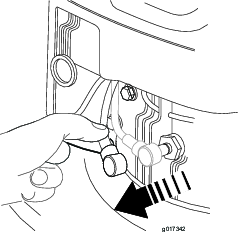
-
After performing the maintenance procedure(s), connect the spark plug wire to the spark plug.
Warning
Tipping the machine may cause the fuel to leak. Gasoline is flammable, explosive and can cause personal injury.
Run the engine dry or remove the gasoline with a hand pump; never siphon.
Important: Always tip the machine onto its side with the dipstick down.
Replacing the Air Cleaner
| Maintenance Service Interval | Maintenance Procedure |
|---|---|
| Yearly |
|
-
Press down on the latch tabs on top of the air cleaner cover (Figure 19).
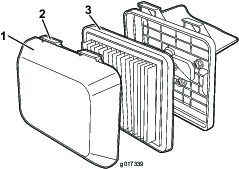
-
Open the cover.
-
Remove the filter (Figure 19).
-
Inspect the filter, and replace it if it is damaged or excessively dirty.
-
Inspect the paper air filter.
-
If the filter is damaged or is wet with oil or fuel, replace it.
-
If the filter is dirty, tap it on a hard surface several times or blow compressed air less than 207 kPa (30 psi) through the side of the filter that faces the engine.
Note: Do not brush the dirt off the filter; brushing forces dirt into the fibers.
-
-
Remove dirt from the air cleaner body and cover using a moist rag. Do not wipe dirt into the air duct.
-
Insert the filter into the air cleaner.
-
Install the cover.
Changing the Engine Oil
| Maintenance Service Interval | Maintenance Procedure |
|---|---|
| After the first 5 hours |
|
| Yearly |
|
-
Ensure that the fuel tank contains little or no fuel so that fuel does not leak out when you tip the machine onto its side.
-
Run the engine a few minutes before changing the oil to warm it.
Note: Warm oil flows better and carries more contaminants.
-
Disconnect the wire from the spark plug. Refer to Preparing for Maintenance.
-
Remove the dipstick.
-
Tip the machine onto its side, with the dipstick down, to drain the used oil out through the oil fill tube.
-
Return the machine to the operating position.
-
Slowly pour oil into the oil fill hole, wait 3 minutes, and check the oil level on the dipstick by wiping the dipstick clean and then inserting, but not screwing in, the oil fill cap into the hole.
Note: Max. fill: 0.59 l (20 oz.), type: SAE 30 or SAE 10W-30 detergent oil with an API service classification of SF, SG, SH, SJ, SL, or higher.
Note: Fill the engine crankcase with oil until the dipstick indicates that the engine oil level is correct as shown in (Figure 20). If you overfill the engine with oil, remove the excess oil as directed in step 5.

-
Install the dipstick and hand tighten it securely.
-
Dispose of the used oil properly at a local recycling center.
Servicing the Spark Plug
| Maintenance Service Interval | Maintenance Procedure |
|---|---|
| Every 100 hours |
|
Check the spark plug after every 100 operating hours. Use an Champion RN9YC spark plug or equivalent.
-
Stop the engine and wait for all moving parts to stop.
-
Disconnect the wire from the spark plug.
-
Clean around the spark plug.
-
Remove the spark plug from the cylinder head.
Important: Replace a cracked, fouled, or dirty spark plug. Do not clean the electrodes because grit entering the cylinder can damage the engine.
-
Set the gap on the plug to 0.76 mm (0.030 inch) (Figure 21).
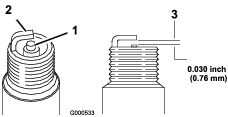
-
Install the spark plug and the gasket seal.
-
Torque the plug to 20 N-m (15 ft-lb).
-
Connect the wire to the spark plug.
Replacing the Blade
| Maintenance Service Interval | Maintenance Procedure |
|---|---|
| Yearly |
|
Important: You will need a torque wrench to install the blades properly. If you do not have a torque wrench or are uncomfortable performing this procedure, contact an Authorized Service Dealer.
Examine the blades whenever you run out of gasoline. If the blade is damaged or cracked, replace it immediately. If the blades edges are dull or nicked, have them sharpened or replaced.
Warning
The blade is sharp; contacting the blade can result in serious personal injury.
-
Disconnect the wire from the spark plug.
-
Wear gloves when servicing the blade.
-
Disconnect the spark plug wire from the spark plug. Refer to Preparing for Maintenance.
-
Tip the machine onto its side, with the air filter up.
-
Use a block of wood to hold the blade steady.
-
Remove the blade (turn the blade bolt counterclockwise), saving all the mounting hardware.
-
Install the new blade (turn the blade bolt clockwise) and all mounting hardware.
Important: Position the curved ends of the blade to point toward the machine housing.
-
Use a torque wrench to tighten the blade bolt to 25 N-m (18 ft-lb).
Important: A bolt torqued to 25 N-m (18 ft-lb) is very tight. While holding the blade with a block of wood, put your weight behind the ratchet or wrench and tighten the bolt securely. This bolt is very difficult to overtighten.
Cleaning the Machine
| Maintenance Service Interval | Maintenance Procedure |
|---|---|
| Before each use or daily |
|
| After each use |
|
Warning
The machine may dislodge material from under the machine housing.
-
Wear eye protection.
-
Stay in the operating position (behind the handle).
-
Do not allow bystanders in the area.
-
Tip the machine on its side.
-
Use a brush or compressed air to remove grass and debris from the exhaust guard, the top cowl, and the surrounding deck areas.
Storage
Store the machine in a cool, clean, dry place.
Preparing the Machine for Storage
Warning
Gasoline vapors can explode.
-
Do not store gasoline more than 30 days.
-
Do not store the machine in an enclosure near an open flame.
-
Allow the engine to cool before storing it.
-
On the last refueling of the year, add fuel stabilizer to the fuel as directed by the engine manufacturer.
-
Run the machine until the engine stops from running out of fuel.
-
Prime the engine and start it again.
-
Allow the engine to run until it stops. When you can no longer start the engine, it is sufficiently dry.
-
Disconnect the wire from the spark plug.
-
Remove the spark plug, add 30 ml (1 oz.) of oil through the spark plug hole, and pull the starter rope slowly several times to distribute oil throughout the cylinder to prevent cylinder corrosion during the off-season.
-
Install the spark plug and tighten it with a torque wrench to 20 N-m (15 ft-lb).
-
Tighten all nuts, bolts, and screws.
Troubleshooting
| Problem | Possible Cause | Corrective Action |
|---|---|---|
| The engine does not start |
|
|
| The engine starts hard or loses power |
|
|
| The engine runs rough |
|
|
| The machine or engine vibrates excessively |
|
|
| There is an uneven cutting pattern |
|
|